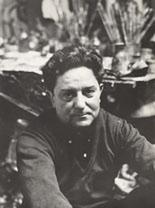
Marcel Pouget was a member of the avant-garde CoBrA group which was formed in 1948 by Alechinsky, Appel, Corneille, and Jorn, it was a reactionary movement seeking free expression of the unconscious unimpeded by the intellect. COBRA was to prove highly important in the development of Modern Art. The motives were comparable to the american action painters, but differed in COBRA’s use of strange fantastic imagery, often relating to Nordic mythology or folklore. Some critics tend to identify Pouget’s works with “halucinatory visions”. The Rimbaud reference made in the title of his first abstract painting, “Le Bateau Ivre”, is an attempt to transform the painter himself into a “prophet”. Indeed, his style is both romantic and desperate. His endless creative energy led him to adopt a mystical attitude to his vision of the world and his work. He often spoke out about his beliefs: “Le créateur, devient à nouveau initiateur, déconditionné et réveillé, ...il voit et perçoit ce que le regard et le mental lui avaient caché. Il domine les techniques qui se soumettent alors à sa germination mystique...”
Pouget was born in 1923 in Oran, Algeria, where he studied at L’Ecole des Beaux-Arts d’Oran. In 1946 he was accepted into the École des Beaux-Arts de Paris, however, after only a week he decided to leave the school as he found it too conventional. Paris would remain his home for the rest of his life, and he quickly became involved in the avant-garde circle, developing strong affinities with abstract expressionists and later, with the COBRA Group, who would pave the way in Europe for the development of a type of informal art with highly expressive features, while maintaining a social, and philosophical commitment.
Further re-integrating the figure, Pouget explored the human condition with ruthless realism. In 1965 the style was termed Nouvelle Figuration, which he describes as “defigurative psychological painting”, producing a subjective language of figurative symbols. These fascinating signs and symbols of his mystical vision have to be decoded in order to fully understand his personal philosophy.
In 1948 Pouget had his first of many solo shows at prominent galleries, as well as the avant-garde salons. In 1954 he exhibited in “Divergence”, at Galerie Arnaud; as well as Galerie Art Vivant with Sam Francis, Serge Poliakoff and Bendt Lindstrom; 1955, Galerie Art Vivant with Appel, Alechinsky, Maryan; 1960, “Kringspontaneism”, Sweden, Norway, Denmark; 1961, Galerie Gummesson, Stockholm; “Ecole de Paris”, Galerie Nova Spectre, The Hague; 1962, American Centre, Paris; Galerie Denise Breteau; 1963, “Idole und Damonem”, Musée de Vienne; 1964, “Figuration et Défiguration”, Musée Gand; Fourth Prize Guggenheim, New York; “Nouvelle Figuration”, The Hague, Vienna, Berlin, Brussels; 1965, Musée Galliera; 1967, Galerie Claude Bernard; Galerie Nord with Maryan and Lindstrom; 1969, Galerie Veranneman, Brussels; 1970, The Hague, Copenhagen; 1976, “Struktur 68”, Stedelijk Museum, Amsterdam; 1978, Palais des Beaux Arts, Lille; 1979, Musée Rodin; and more recently retrospectives in 2004 at Espace Paul Rebeyrolle, and 2006 at Galerie Ariel, Paris.
Pouget’s work is now represented in many major public collections including: Muse d’Art Moderne de la Ville, Paris; Musée National d’Art Moderne, Paris; Musée National, Algeria; Musée d’Art, Tel Aviv; Museum of Contemporary Art, Skopje; Museum of Art, Vienna.